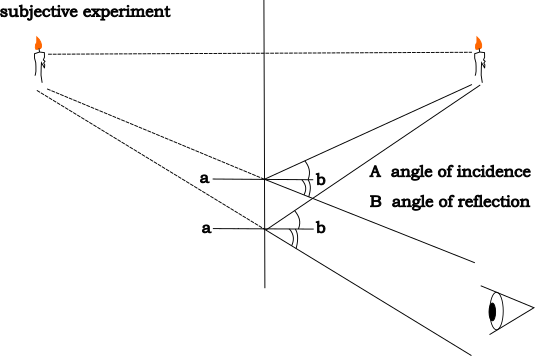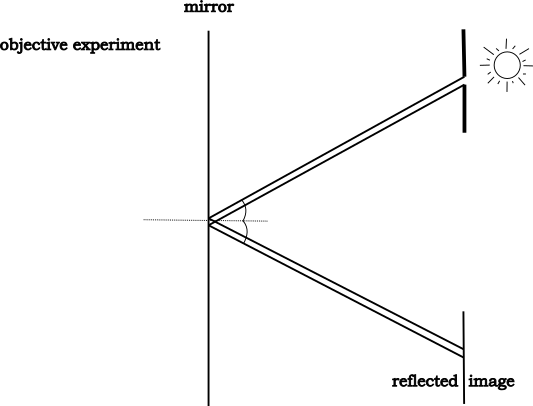Color Theory and Light
GA 91
6 August 1903, Berlin
Translated by Steiner Online Library
Lecture Four
Until the nineteenth century, the substance theory or emission hypothesis—emission of a light substance—was valid for the explanation of light phenomena, because it was not possible to refute this theory physically by experiments. The correctness of the substance theory depends on the fact that light added to light gives greater brightness.
In the nineteenth century Fresnel proved by experiment that light is a motion, a vibration. Light is vibrating motion. The proof lies in the fact that light brought to light can result in darkness.
The law of reflection is: a ray of light is reflected back from a reflecting wall in such a way that the angle of incidence is equal to the angle of reflection.

This law is found as follows: We place a light in front of a mirror and receive the reflected beam in our eye. Between the lines of the Sun's outgoing rays and its reflected ones we draw a perpendicular line and in this way we get two acute angles. We call the first angle (angle A) angle of incidence, the second one (angle B) angle of reflection (subjective experiment).

The same law applies to the objective experiment: we let a ray of light enter through an aperture onto a mirror in a darkroom; we get the Sun's light reflected onto the opposite screen: at the point of intersection, the perpendicularly drawn line gives the two equal acute angles: angle of incidence and angle of reflection.
If we now set up two mirrors with angles inclined to one another, from the two mirrors the received light image is reflected back in such a way that one Sun disk coincides with the other.—We can then have either light or dark. Light added to light can give darkness.
From this it follows with irrefutable force of proof that light is not matter (for then matter added to matter would give more light) but motion. In motion, vibrating particles can be accelerated by a new impulse in the same direction, that is, amplified, or inhibited and brought to a standstill when they collide. Light is vibrating motion.
If we let the light rays fall on the mirror through a grating, the reflection on the screen gives light and dark side by side.
Motion presupposes a substance which is set in vibration. This is the ether. The Sun's rays vibrate in four different types of ether. They yield heat, light and chemical effects; in their finest state they are the substance of life—prana (life ether). Thus, in our physical matter we have solid, liquid, gas, and four etheric types. We find them in the plant:
- The plant takes in matter and transforms it (chemical/formative ether).
- The plant shows its parts colored (light ether).
- The plant needs warmth for its activity (warmth ether).
Farben- und Lichtlehre IV
Bis zum neunzehnten Jahrhundert galt für die Erklärung der Lichtphänomene die Stofftheorie oder Emissionshypothese — Ausströmung eines Lichtstoffes -, weil man diese Theorie nicht physikalisch durch Experimente widerlegen konnte. Die Richtigkeit der Stofftheorie hängt davon ab, dass Licht zu Licht hinzugebracht größere Helligkeit gibt.
Im neunzehnten Jahrhundert bewies Fresnel durch Experiment, dass Licht eine Bewegung, eine Vibration ist. Licht ist vibrierende Bewegung. Der Beweis liegt darin, dass Licht zu Licht gebracht Dunkelheit ergeben kann.
Das Gesetz der Reflexion ist: Ein Lichtstrahl wird von einer spiegelnden Wand so zurückgeworfen, dass der Einfallswinkel gleich dem Reflexionswinkel ist.

Man findet dieses Gesetz folgendermaßen: Wir stellen ein Licht vor einen Spiegel und empfangen den zurückgeworfenen Strahl in unserem Auge. Zwischen den Linien des hin- und zurückgeworfenen Strahles ziehen wir eine senkrechte Linie und bekommen auf diese Art zwei spitze Winkel. Wir nennen den ersten Winkel (Winkel A) Einfallswinkel, den zweiten (Winkel B) Reflexionswinkel (subjektives Experiment).

Dasselbe Gesetz gilt beim objektiven Experiment: Wir lassen durch eine Öffnung den Lichtstrahl auf den Spiegel einer Dunkelkammer fallen und erhalten auf dem Schirm gegenüber reflektiert die Sonnenscheibe: Am Schnittpunkt ergibt die senkrecht gezogene Linie die zwei gleichen spitzen Winkel: Einfalls- und Reflexionswinkel.
Stellen wir nun zwei Spiegel mit zueinander geneigten Winkeln auf, so wird [von] den beiden Spiegeln das empfangene Lichtbild so zurückgeworfen, dass eine [Sonnenscheibe] mit der anderen zusammenfällt. - Wir können dann entweder hell oder dunkel haben. Licht zu Licht hinzugebracht kann Dunkelheit geben.
Daraus folgt mit unwiderleglicher Beweiskraft, dass Licht nicht Stoff ist - denn dann würde Stoff auf Stoff gefügt mehr Licht geben -, sondern Bewegung: In der Bewegung können die vibrierenden Teilchen durch einen neuen Impuls in dieselbe Richtung beschleunigt, das heißt verstärkt werden oder gehemmt und zum Stillstand gebracht werden, wenn sic aneinander stoßen. Licht ist vibrierende Bewegung.
Lassen wir die Lichtstrahlen auf den Spiegel durch ein Gitter fallen, so ergibt die Reflexion auf dem Schirm Hell und Dunkel nebeneinander.
Die Bewegung setzt einen Stoff voraus, der in Schwingung gesetzt wird. Dies ist der Äther. Die Sonnenstrahlen schwingen in vier verschiedenen Ätherarten. Sie ergeben Wärme, Licht und chemische Wirkungen - in ihrer feinsten Rate sind sie der Lebensstoff, Prâna. So haben wir in unserer physischen Materie Festes, Flüssiges, Gas und vier Ätherarten. Wir finden sie in der Pflanze:
1. Die Pflanze nimmt Stoff auf und verwandelt sie: chemische Wirkung.
2. Die Pflanze zeigt ihre Teile gefärbt: Lichtäther.
3. Die Pflanze braucht zu ihrer Tätigkeit: Wärmeäther.

